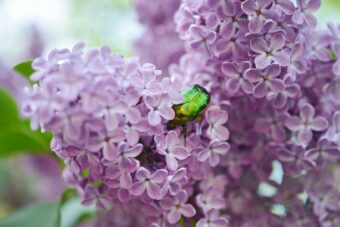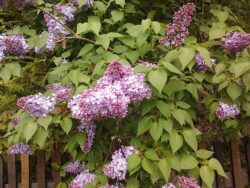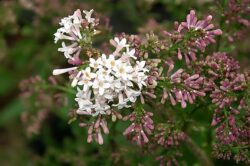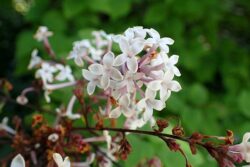In this article, we will discuss how to grow Syringa (Lilacs) in containers. You often see large lilacs in gardens throughout the UK and you wonder if they can be grown in containers? In this article, this question will be answered.

They are beautiful shrubs that have beautiful blooms and an unmistakable fragrance. To those who have a big garden, it is a must, but for those who have small gardens or unsuitable growing conditions, then it is best to grow them in containers.
Lilacs by their nature prefer to grow in the ground where the roots are allowed to roam free. This means they will not be happy in containers unless you meet some basic rules.
Rule number 1 is to buy a dwarf variety such as ‘Minuet’, ‘Pixie’ and ‘Manchurian’. If you cannot find dwarf varieties, you can use species that remain small such as Syringa meyeri, Syringa pubescens or Syringa patula.
Syringa provides structure and continuity throughout the year and requires very little maintenance.
GROWING SYRINGAS IN CONTAINERS
If you grow Syringa in containers, you will need to use a wooden oak half-barrel. No matter what you use it must be large as possible. Line it with a plastic liner to stop the wood from rotting and make sure it has an adequate number of drainage holes at the bottom. The container must be ridged and well looked after.
To the selected container add a 2.5cm layer of gravel to help any excess water to drain away. A very important step.
The main drawback is that lilac hates acidic soil to which most composts are. To remedy this, mix 540 grams of garden lime for every 50 litres of compost. Mix it well together and fill the container with this mixture. You can check with a pH meter to make sure that the soil’s pH is greater than 7. Dig a hole that is twice as wide as the root ball of the original container- no lower and no higher. Backfill with the growing media ensuring that any gaps are filled with more potting mix. Firm the plant in and water well.
Remember to place your container in its final position as once the plant is in and the container is filled it will be difficult to move. The container should be placed in a location where sunlight is maximised and the plant gets at least 6 hours per day.
WATERING IS VERY IMPORTANT

Watering is a must and the compost should not be allowed to fully dry out. The container will need to be watered frequently in hot, dry spells. Water when 2.5cm below the top of the surface of the compost feels dry to the touch when you stick your finger in. Water until it emerges from the drainage holes.
An annual feeding with a slow-release fertilizer in spring will help your plant to flourish throughout the growing season. Bonemeal is ideal as it will prevent the compost from becoming too acidic.
WINTER CARE FOR SYRINGAS IN CONTAINERS
Lilacs in containers may need some winter protection but do not bring them inside a greenhouse or conservatory. The reason for this is that the plant will need cold temperatures to produce flowering buds for next year’s show. Severe cold temperatures below -10 degrees Celsius can damage the roots of the plant.
You can protect the plant by burying it in the garden but this is difficult if it is heavy and full of compost and a plant. Another option is to wrap a thick horticultural fleece around the pot to protect the roots. This will keep it warmer around the root area. In most of the UK, we will not get cold enough to seriously harm the plant.
PESTS AND DISEASES

Lilacs attract few pests such as caterpillars and leaf miners that cause limited damage but one pest to look out for is scale. If you find scale insects on your plant, it is best to spray with neem oil at 14-day intervals or by using a suitable systemic insecticide.
Lilac can suffer from bacterial blight that causes shoots and branches to die back and leaves to shrivel. Leaf spots will develop water-soaked areas that will soon turn brown. Flowers may turn brown and die suddenly. The best way is to trim every diseased branch but if the infection is widespread you may need to use a broad-spectrum fungicide to treat it.
Powdery mildew is the most common problem in lilacs. Increase air circulation and infected branches by thinning the plant annually. You can use fungicides to treat the conditions successfully.
Leaf spots caused by various fungi pathogens can cause brown spots to appear on the leaves. They may or may not cause the leaves to drop off early.
This can be treated by improving the air circulation around the plant and by practising good cleaning and husbandry around the plant.
VARIETIES TO GROW
‘Flowerfeste Pink’ is a 1m tall variety that has pink flowers in spring to summer, and then again in late summer until the first frosts.
‘Flowerfeste White’ is a 1m tall variety that has white flowers in spring to summer and then again in late summer until first frosts.

‘Dwarf Pink’ grows up to 1m tall, where it will produce pink flowers from May to June.
‘Dwarf Blue’ grows up to 1m where it produces blue flowers in late spring and early summer.
‘Tinkerbell’ where wine red flowering buds open in late spring to give a starry show of pink flowers. Grows up to 1.2m in height.
CONCLUSIONS
In this article, we have discussed how to grow Syringas in containers. As you can see there are lovely shrubs that produce beautiful, elegant, scented flowers and are easy to grow as long as the roots are protected from the severe cold.
A plant that you would want in your container display.
If you have any comments that you wish to make on growing Syringa in containers, please do so in the comment box below.
Happy Syringa growing.
